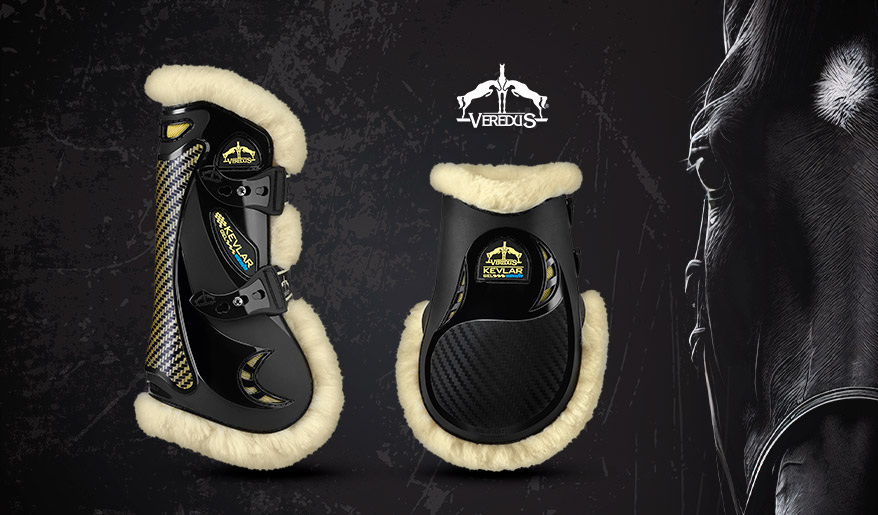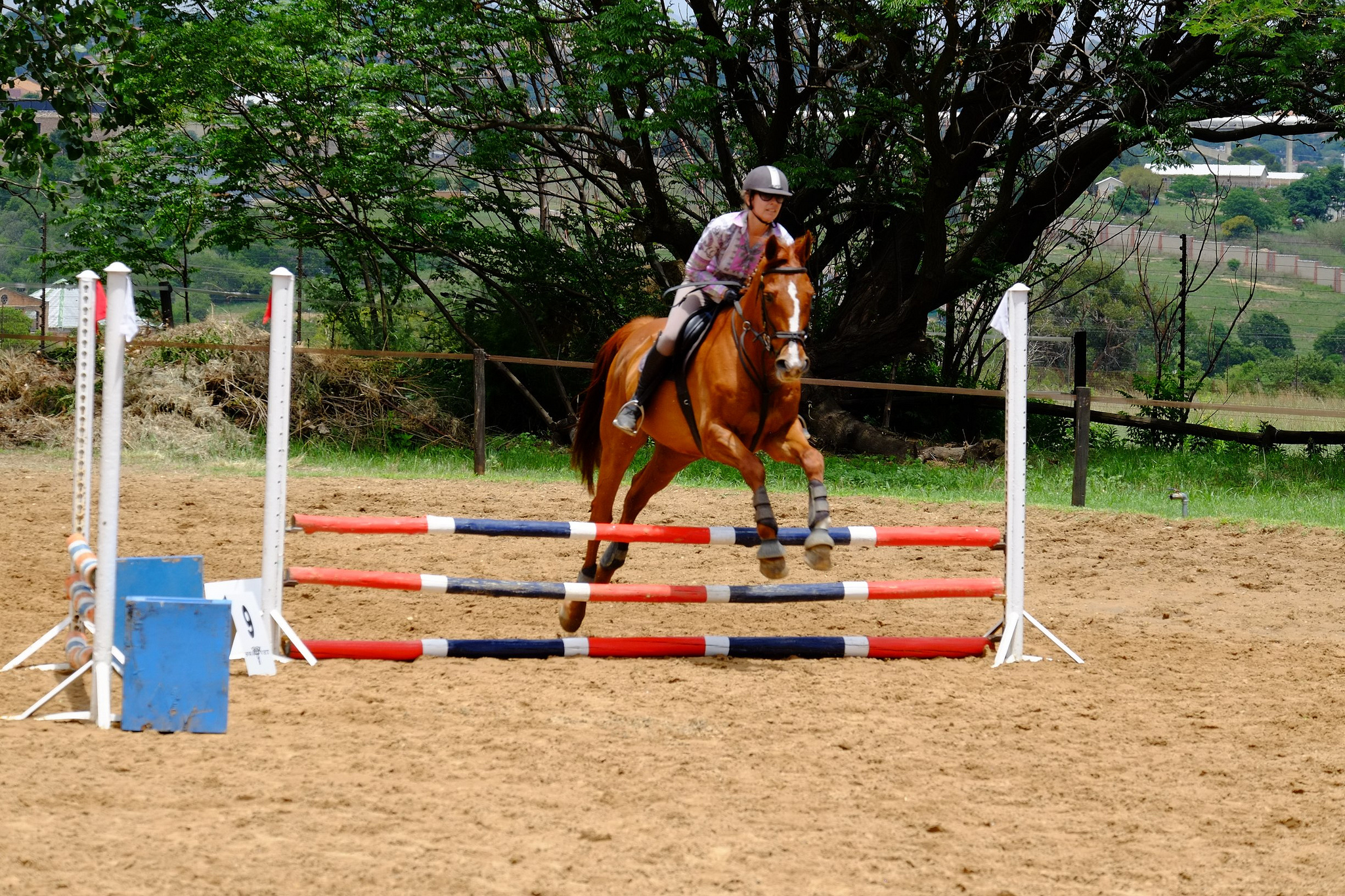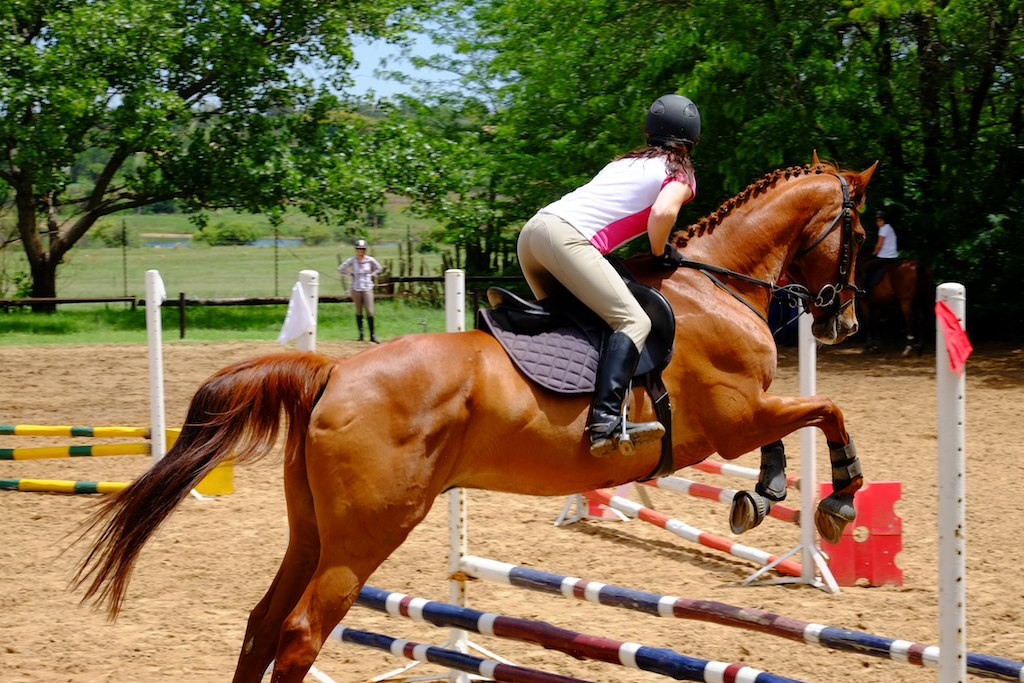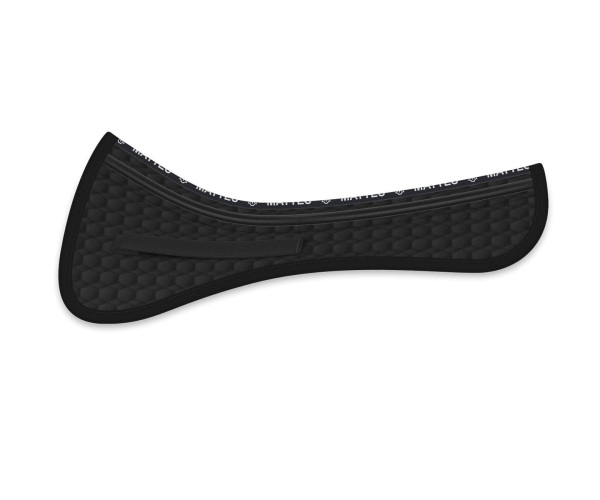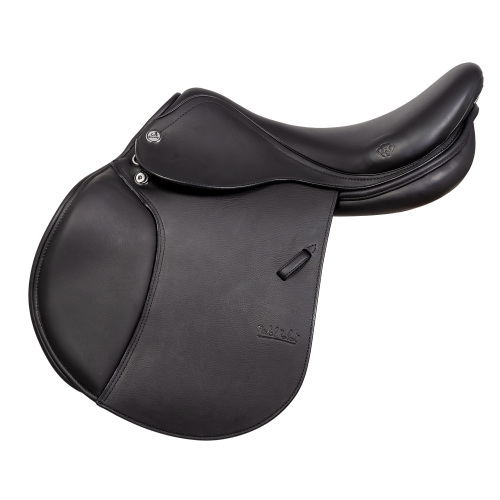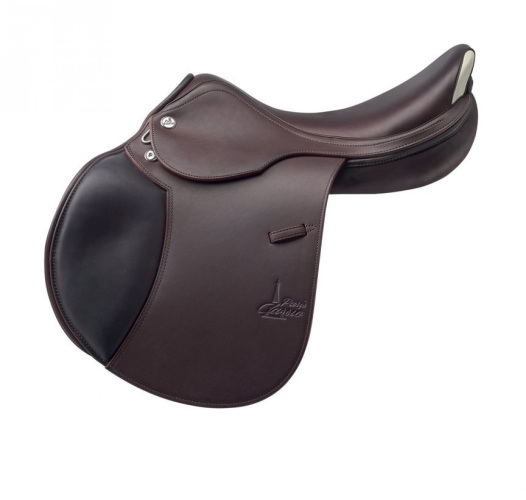
background source: blogs.wsj.com
There are many reasons for which a horse does not want to jump over an obstacle. An effective rider is capable of identifying source of the problem and how to change the situation. In order for everyone to become this rider, let's take a look at a few most popular horses' "problems" occurring while jumping. We will try to show you solutions which will allow you to change such upsetting (both for the rider and the horse) situation.
- The horse is tearing at an obstacle.
- The horse does not want to jump.
- The horse jumps "lousily".
- The horse jumps diagonally.
- The horse turns off, not riding straight forward.
The horse is tearing at an obstacle
Causes:
In reality, there is more than one reason for which the horse is tearing at an obstacle.
- One of the reasons might be his will to be done with the jump as soon as possible and all the unpleasantness it brings with itself. Maybe the horse has some bad memories from the past, if the person who introduced him with the "jumping world" had insufficient skills to do that properly. Also, there is a possibility that the steed crashed into an obstacle some time ago and got scared, therefore he built the association jumps = pain. As you can see, most of the problems are just bad associations with a jump or an obstacle, and that results with fear.
- If your horse is a folblut or an Arabian horse after races, his racing at the obstacles is not a result of fear, but a habit and temperament. Creating a new model of behaviour while riding at an obstacle will require a lot of patience and time. However, it is possible to "un-teach" the horse such behaviour.
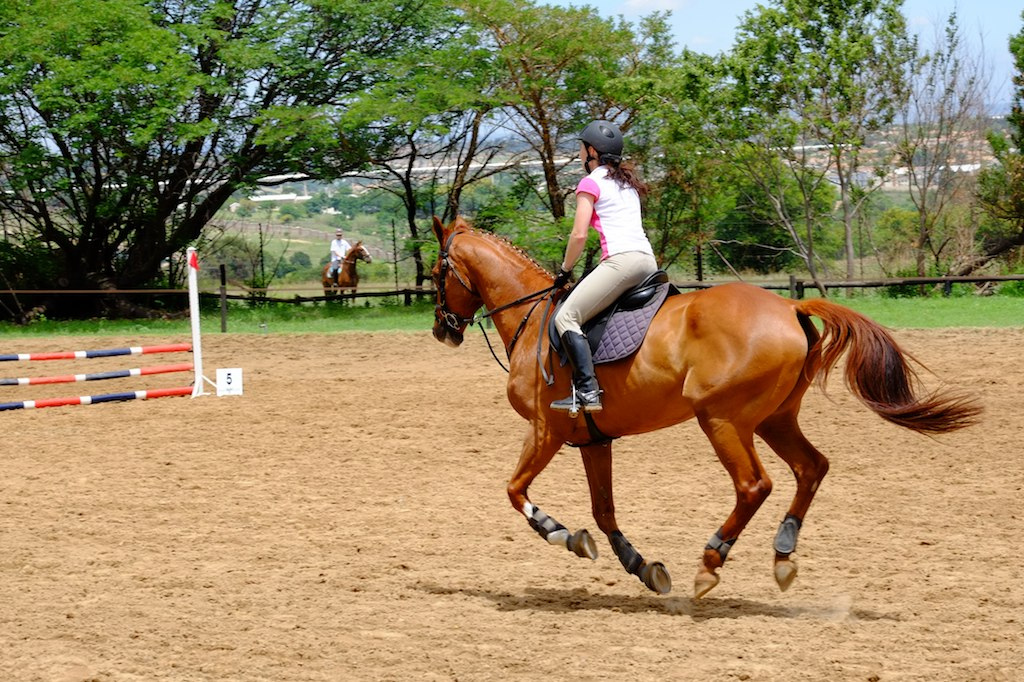
Picture's author:
Robert Dennison |
CC BYSolution:
- During training try to not think about the jumps, because if you will get excited and scared "Oh my God, we will jump! He will pull again!") then your horse will perfectly sense and acquire your emotions. Try to lead your horse calmly through all the exercises.
- At first, arrange some sort of a little envelope or straight rails (50-60 cm), so the jump will not tire the horse too much and so you can repeat it many times. Make short approaches on the obstacle. Start from jumps at a trot, then at a canter for approximately 2-3 foules. The horse will not be able to race and will maintain even tempo without the unnecessary "fight" before an obstacle, which unfortunately perpetuates the undesired habit of speeding.
- In the next stage (not necessarily during one training) you can try a longer approach (6-7 foules). However, at the moment you feel that your horse is racing immediately resign from jumping and make a volte. The whole point is that your horse cannot know that you resigned from jumping. Also, you cannot turn 90 degrees for 1-2 foules before jumping, because that is exactly how you teach your horse to refuse performing a jump in the future. So the best way to do this, is to start from a big volte before the obstacle, so you can escape it any time you want and be able to jump. Such exercise also teaches the horse to maintain regular tempo, and the rider to be constantly focused and in control of the situation.

- In order not to ruin the exercise and tempo before the obstacle, mind for the horse not to speed after the jump either. After the jump ride 1-2 foules straight and then perform a volte, and make the horse return to the proper tempo, not allowing him to speed. After 1 or 2 circles at a canter, also in a circle you can shift to a calm trot, and then even to a walk. For diversity, you should try to make alternating voltes - once to the left, and once to the right.
Note!
Fighting with your horse before an obstacle, changing the curb bit for a rougher - will not solve the problem, they can only worsen the situation and prolong the process of "fixing". The habit of tearing at an obstacle might take roots and be harder and harder to eliminate, despite the fact that its cause is long gone. In such a case, it can be a hard, even Sisyphean job.
The horse does not want to jump
Causes:
- If the horse approaches the obstacle and refuses to jump right before it by stopping abruptly, and you lose your balance, landing on his neck, ground or behind the obstacle it means that you ride a very intelligent creature :) You pet has already noticed that you do not mind the impulse before the obstacle and you do not have control over him, so he uses the situation.
- Jumping too high obstacles for which you are not ready yet.
Solution:
Is really simple. Like above, you can start with shorter approaches, so that your horse would not have time to wonder. Also, ask a coach that will tell you how to use aids for help. We recommend to ride with closer contact, at a canter in full seat, to "ride" the horse well to the obstacle and help yourself with a jumping bat on a foule before the obstacle and the voice, uttering a motivating command of your choice loud, clear, and short (for example "Go!" or "Jump!"). However, remember that the jumping bat is supposed to strengthen the actions of your aids, not to replace them! At first you will most definitely have to make a few jumps from stops, but do not give up - after few tries, your horse should jump over the obstacle easily.
Another crucial thing is where you look while approaching the obstacle. Often "lowering your sight" before jumping results with resigning in the last moment. For a horse who learnt to resign this little "mistake" might be a sufficient cause of such behaviour.

source: joursdecheval.fr
It is important to mind the horse while approaching an obstacle and to not wait for his "quirks". You are in charge in this team, so you have to decide. Thus try to energetically approach the obstacle, not allowing your horse to speed. If the horse gets excited and tries to escape your control - immediately perform a volte. Jump only when the tempo is right. Why is it so important? Because a horse who knows that he can "lead us astray" surely will do that. If you will not allow him to control the situation and each of his attempts end up with failure - eventually he will stop testing you :)
If you jump obstacles that are too high, for which you are not ready yet, you will always feel scared and insecure when the moment of taking off is approaching. That makes no sense, because if you are not sure if you want to jump or not, your horse feel it even more :) In such case, it is good to go back to the basics, improve your jumping technique and balance until you feel more certain. You can always change the obstacles' height. Remember that the higher the obstacle, the more visible your mistakes during the jump.
Lazy jumper
Calm horse that never causes trouble loses his enthusiasm during jumping. He is spiritless, it is hard to force him to approach the obstacle energetically. He often stops before the obstacle and eventually jumps from a stop. His jumps are not energetic and he often "taps" the poles with his hooves or even knocks them to the ground.
Causes:
- Like in the previous example - maybe the horse found a way to trick us - you allow him to take control and he is taking advantage of it. He knows that jumping requires a lot of energy from him, so if he does not have to jump - he would rather postpone this moment. Maybe you would give up?
- The horse is bored with training. Usually jumping takes place after approximately 20-30 minutes of riding, during which instead of warming your horse up, you made him fall asleep.
- Exhaustion of the steed.
Solution:
- If the animal initially is keen to jump or is just involved into every exercise and as the time goes, his energy lowers - it means that our training should have ended a long time ago. Tired horse will not jump well and you cannot make progress in such a way. Try to jump less on lower obstacles. Provide him with longer breaks for a walk. Maybe he is not yet physically ready for such marathon. Also, remember that the horse should leave the manage only when he is relaxed and content about the workout, so he would want to come back for another ride and give even more from himself. It is good to train more often but shorter. Also, do not cross the line with the amount of exercises on poles and obstacles.
- Do not accept the horse's qualified reaction to activating aids.
- Try to diversify the lessons for the horse, even if he seems like he knows everything already. Often change the size, appearance and placing of the obstacles - your horse needs new challenges :) If you fail to focus his attention on the exercises, he will get sleepy. Try to work with him on poles and cavaletti, often changing directions - that will additionally diversify your training.
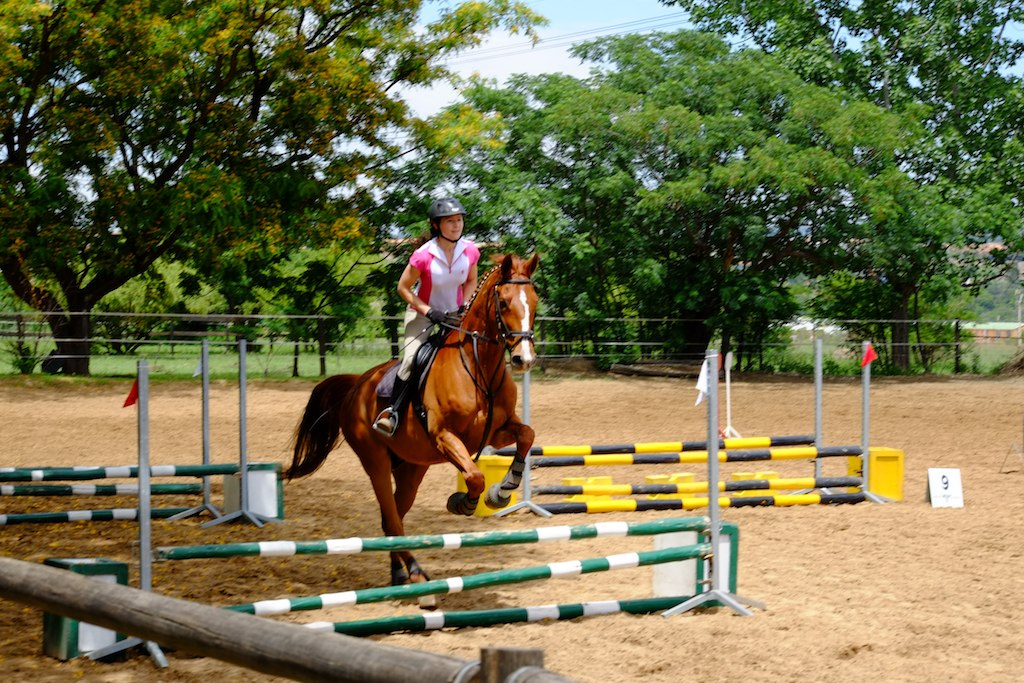
Focusing the horse's attention on the training is already half a success. Photo's author:
Robert Dennison |
CC BY- When the horse knocks out the obstacle or "taps" a pole with his hoof, try to find out why that happened. The most common reason is imperfect technique, your balance problems or troubles with adapting the step length - foules.
- A good exercise for warming your horse up is jumping at a trot. Horses easily jump a pretty high obstacle at a trot, but they have to learn that they can :)
Exercise: jumps at a trot
Arrange a little straight rail or an envelope (50 - 60 cm) with pointer at a trot (approximately 80 cm). Try to approach is at an energetic trot and try to make the horse jump it.
Note!
For a moment before jumping, it is good to catch the crest and give the horse a lot of ease on the reins. Why? The horse while approaching at a trot will "jump" from under us and you, instead of hanging on the reins and hit him with a bit on his teeth, will keep you balance and will not cause him pain, at the same time not punishing him.
If the horse stopped before the obstacle, it is good to help yourself with the stronger calf and jumping bat, performing a jump from stop. However, at the next approach, knowing that your horse resists, get ready. React earlier. Use your aids stronger - seat, calf and jumping bat additionally.
If the horse performs the jump extremely lazily and lousily, use your calf and jumping bat once more, right after landing, so the horse will run at an energetic canter. It is good to pat him, so he will not get nervous, then shift to a trot and try to jump again. Surely you will feel that the horse is more interested in the jump, and his trot will be more energetic.
The horse jumps diagonally
Some horses stubbornly jump not through the middle of an obstacle, but diagonally, for example starting closer to the right end of a pole and landing closer to the left. It is not necessarily an effect of the rider's mistake while approaching the obstacle, sometimes it is just the horse's bad habit.
Causes:
- If the horse earlier jumped in a straight line, and then suddenly started jumping diagonally - it might be a symptom of some health issue.
- The horse has acquired a bad habit, due to being multiply wrong lead on the obstacles.
Solution:
In general, why does jumping diagonally can be a problem? You will find out if one day you will painfully hook your leg on a pole. It is also a problem when you jump really high obstacles. Diagonal jump is longer than jump in a straight line, so it will require stronger take off and longer phase of flight from your steed. Thus, why would he lose strength, necessary on the parkour, on such longer jumps?
If your horse has recently started jumping diagonally, it can be a slight signal for us that there is something wrong with his health. Start with thoroughly checking his hooves, navicular bones, hocks, back muscles, spine etc. Push all the mentioned places, observing the horse's reaction. Maybe there is something wrong with him that is not possible to see at the first glance.
If you are sure that your horse is fine and he just acquired this undesired habit - below, we present you with an exercise that will help you teach your horse again. However, remember that you have to be patient. Like we mentioned before, teaching the horse a "new" habit, which will eliminate the old one, takes a lot of time and requires long and systematic work.
Exercise: restricting poles after landing behind the obstacle
Arrange a low (50 - 60 cm) envelope or straight rails, with time raising it to medium (70 - 80 cm). Behind the obstacle place two poles creating the "V" letter like on the picture below. First, make a distance of approximately 1,5 - 2 m between the closer ends. When the horse understands what it is about, you can extend this distance.
Start from jumping at a trot, then at a canter, until the horse will be able to jump perfectly through the middle between the two poles. If the horse ignores them, you can replace them with cavaletti, or just raise two ends of the poles (those 1,5 - 2 m away from each other) leaning them on some blocks, tires etc. That should force the horse to respect them and be more mindful.

While jumping, do not use your hands too strongly, allowing the horse to get rid of this diagonal jumping on his own.
The horse forks, not riding straight forward
Causes:
- Young and unexperienced horses very often has troubles at the initial phase of learning with moving in a straight line.
- Lack of the rider's proper control over the horse and the ability to lead him after the obstacle.
Solution:
- If this problem appears at a young or unexperienced horse, do not get mad and do not try at all costs with the use of your hands to lead him straight. Instead, focus on the purpose of your ride right after landing behind the obstacle. Focus on this and lead the horse, holding him in your aids - legs and arms.
- If the rider's lack of control is the cause (which we mentioned before) and before the jump, the horse does not feel that the rider is in charge, he will surely try to use it right behind the obstacle, forking to the left or right. Especially the school horses - recreational, very often "check" their riders in such a way :) Thus, it is good to obey the aforementioned remarks - concentration on the purpose of the ride (look where you want to go after the obstacle while you are still above it), proper and consistent use of aids is the most important.
Below, we present you with an exercise that will be perfect not only for the unexperienced horse, but also for the unexperienced rider on the school horse. Additionally, the below arrangement prevent the horse from moving zigzag between another obstacles in the line.
Exercise: track from poles between the obstacles

Do not arrange high obstacles. Start from jumping at a trot, then change the distance between pointer and envelope and try to jump at a canter.
Most important rules concerning elimination of the horse's mistakes during jumping:
- Do not jump the whole parkour. Repeating an exercise on one obstacle (straight rails or envelope) of slight height (40 - 50 cm) will allow you to eliminate mistakes.
- Do not expect to fix the mistakes during one training. Usually the horse's improper behaviour has already become his habit. Thus, you have to be very patient and be prepared for the "unteaching" and teaching him a new "pattern of behaviour" during jumping might take a lot of time (even a year). All depends on how deeply the reaction has been rooted in the horse.
- It is good to consider if we ourselves are not the cause of the horse's mistakes. If you lack balance, you cannot follow the horse with your body and "give" him the hand while jumping, be aware that each jump with you on the horse's back is not a pleasant experience for him. First, you should take some time to work on yourself, preferably with a coach and a professor-horse (experienced), who will forgive you all your mistakes and shortages.
- If you have troubles with the horse during jumping, the cause is in the lack of solid dressage basics and trust towards the rider. If you omit certain elements of training, sooner or later you will have to go back to them. Thus, it is not worth to lose time on re-learning from the basics. Try to train your horse step by step, without rushing another stages of teaching.
Also, remember that the very basics in jumping is always the helmet. Therefore, it is good to invest in a high-quality helmet that would take the impact, having all the necessary certificate and meeting all the European standards. You should also purchase a solid vest that would protect you from the most serious injuries during falls.
We hope that our tips will prove helpful! Soon we will publish next part of this article, discussing other types of mistakes made by the horse on the obstacles :)








